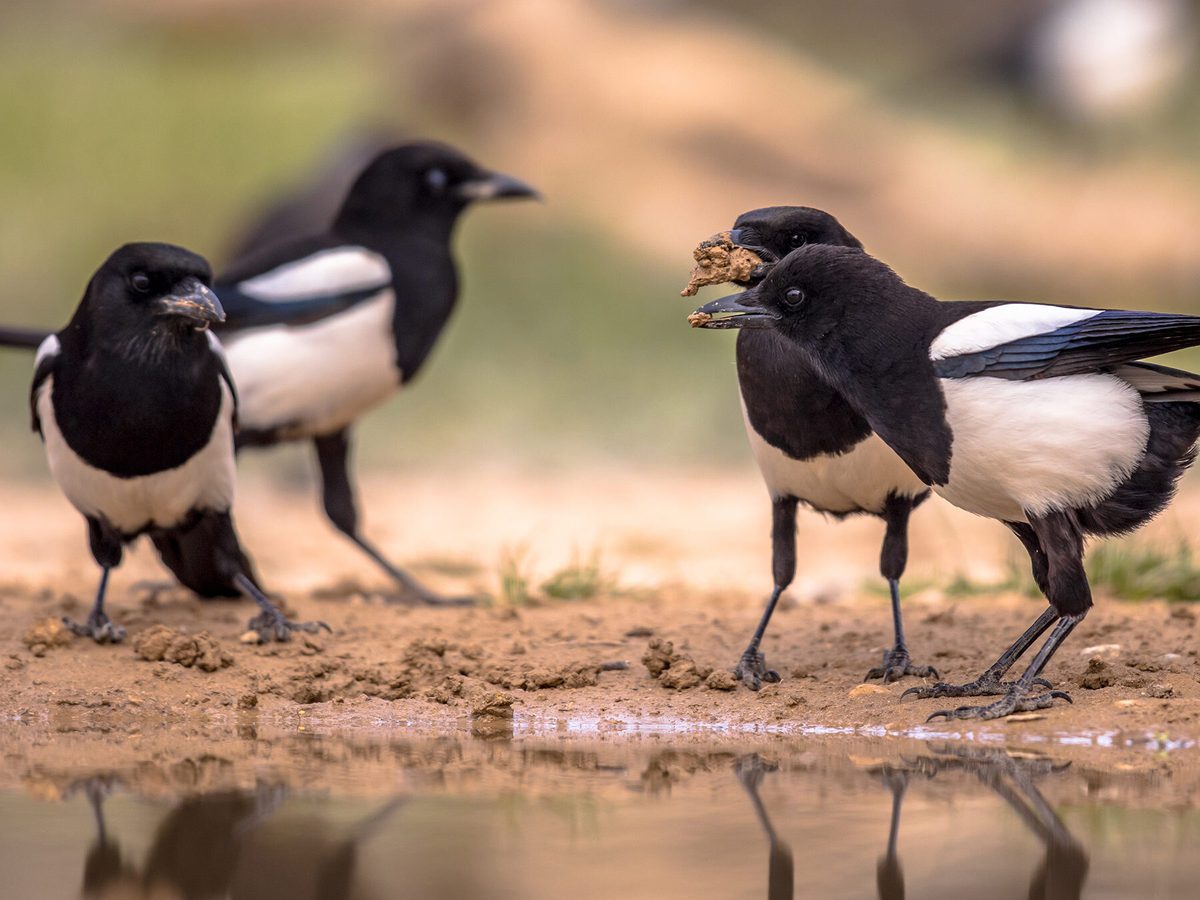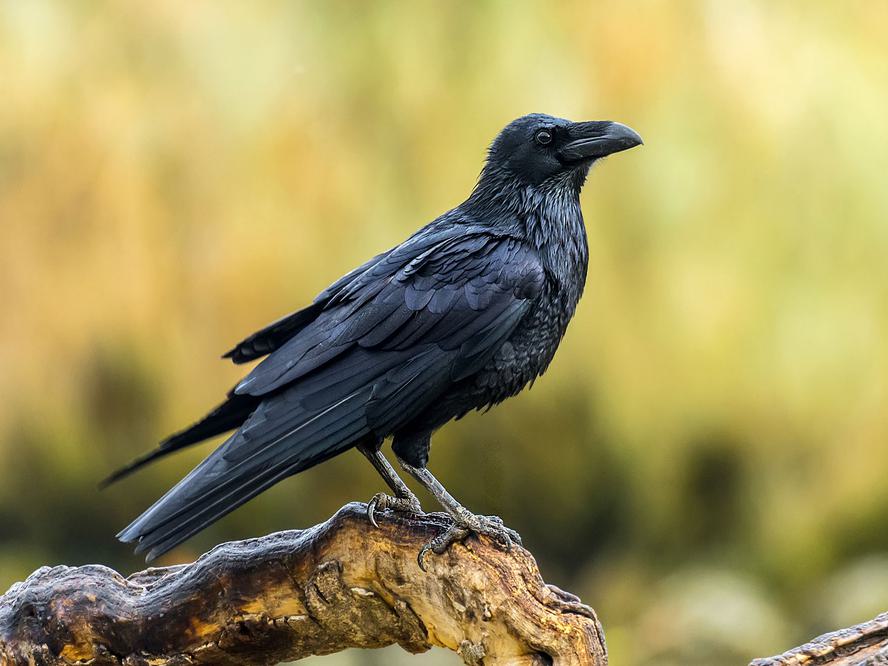Jump to Section
What is a Group of Magpies Called? (Complete Guide)
Last updated: 5 March 2023

Magpies from the Corvidae family are some of the most intelligent birds on the planet and are amongst very few animals that can recognise themselves in a mirror. Magpies are highly flexible and adaptable and represent many more species than the typical black and white Eurasian and Black-Billed magpies, but do magpies flock together, and what is a group of magpies called?
There are many collective nouns for groups of magpies, but perhaps the most common are a mischief, conventicle, congregation, charm and tribe of magpies. Like crows, magpies are sometimes referred to as a murder, and like owls, they’re sometimes referred to as a parliament.
Whilst spotting small flocks of magpies is not uncommon, the sociability of magpies is highly variable. Read on to discover more about the social behaviours of these incredibly intelligent birds!
Other terms for a group of magpies
- A charm of magpies
- A congregation of magpies
- A flock of magpies
- A gulp of magpies
- A mischief of magpies
- A band of magpies
- A murder of magpies
- A tiding of magpies
- A tidings of magpies
- A tittering of magpies
- A tribe of magpies
Whilst some of these charms seem apt, including a congregation of magpies and a mischief of magpies, a charm of magpies seems somewhat contradictory to a murder. But actually, magpies are generally very colourful birds, and some, like the Taiwan blue magpie and Javan green magpie, look very charming indeed!

A flock of three Eurasian Magpies, perched on an old tree
Do magpies flock together in groups?
The social and flocking behaviours of magpies vary widely between the four genera of the Corvidae family that contain magpies. The Eurasian magpie, the most common magpie in Europe, is generally solitary when mated, and it’s only the non-breeding, single birds that tend to form flocks in the breeding season.
Multiple birds are often seen feeding together, but the flocks are generally small - around 10 to 20 birds.
The Black-billed magpie, primarily distributed in North America, does, however, form larger flocks, particularly outside of the breeding season, though mated pairs are also quite solitary when nesting. Black-billed magpies form complex social hierarchies in their flocks where younger individuals are not always tolerated by the adult males.
Perhaps the most social and gregarious magpie is the Yellow-Billed magpie which is well-known to form large communal roosts in winter and often forage together, even exhibiting cooperative behaviours between different mated pairs.
Of the more tropical species of magpies, Taiwan blue magpies are known to form close-knit groups of some 3 to 12 birds. Where magpies do migrate, they tend to fly together in a line formation.

Close up of a Eurasian Magpie (Pica pica)
Why is it a mischief of magpies?
By dancing and prancing around, stealing food, causing a disruption to other birds and cackling maniacally, magpies have a reputation for mischief - and also for theft.
The opera La Gazza Ladra (The Thieving Magpie) is written about a French girl who is tried for theft and executed, but the true culprit is revealed as none other than a magpie. It is perhaps now considered a longstanding myth that magpies steal shiny objects - including jewellery - to take to some sort of treasure cache they have hidden nearby.
Recent studies have put the idea to the sword, and the findings generally show no affinity between magpies and shiny or illustrious objects. One study by the University of Exeter even found that magpies were cautious around shiny objects instead of attracted to them, though you could argue that this still signals some level of interest.
It would be fair to say that magpies do not have a resoundingly positive reputation, at least not in Europe, where they’ve frequently been viewed as a bad luck charm. This contrasts to other Corvids, like the raven, who is often portrayed as a magical being. The status of magpies as unlucky birds is not universal, as in China, they are actually thought to bring good fortune. In fact, most cultures held magpies in high regard before the middle ages.
Magpies do have a genuine darkside, too, as they’re known for raiding other birds’ nests, eating eggs and attacking nestlings. They can also gang up on birds and other animals, called ‘mobbing’, which can be pretty brutal and merciless.

A bunch of magpies
When do magpies flock together?
Most species of magpies become more isolated throughout the breeding season. All magpies are typically monogamous, forming strong, permanent pair bonds that last for their entire life. During the breeding season, the pair will work together in isolation from other birds, though they’ll still often come together with others to feed.
The exceptions are non-breeding birds who are yet to find a mate. Younger juvenile magpies often join flocks, called bands, where they remain until they form mated pairs.
Magpies are generally gregarious for a good portion of the year, and some species, such as the Yellow-Billed Magpie, roost communally over winter. Flocks of magpies likely number 10 to 20 rather than hundreds or thousands of birds, as is the case with some highly gregarious birds like starlings.

Three Magpies gathered together on a rotten tree stump
Why do magpies group together?
Magpies primarily flock or group together in the non-breeding season, to both roost and feed together. Roosting, the process of birds ‘bedding in’ for the winter, is often communal, enabling birds to share body heat and resources to aid survival.
In addition to feeding and roosting, magpies also flock together in their juvenile groups to find mates. Larger groups of magpies are thought to congregate to resolve social standings and form territories, hence why groups of magpies might be called ‘parliaments’.
Perhaps most intriguing are the ‘funerals’ that magpies (and other corvids) are observed to hold for their dead comrades. People have described many magpies gathering around the corpse of another to sing in unison before flying off, others claim that attendees bring offerings of blades of grass and other objects.
These funeral events are not pure speculation - they are scientifically documented - but the true motive behind them is largely unknown, with some arguing that they are an expression of emotional grief and others arguing that they serve as a sort of life lesson that informs the birds of the cause of death, i.e. a postmortem, enabling them to make better survival decisions.
How many magpies are in a flock?
Magpie flocks are generally small, rarely numbering more than some 25 birds. Winter roosts may be much larger, possibly numbering hundreds of birds, but it’d be rare to see this many magpies together in one space.

A large group of Australian Magpies gathered in a backyard
Do magpie families stay together?
The familial behaviours of magpies are not usually as complex as crows (also in the Corvidae family), whose older children even help their parents raise their next year’s siblings.
Magpie chicks usually fledge after just a month or so but remain dependent on their parents for several more weeks, perhaps leaving to join a juvenile flock at the end of the year, in winter.
This does vary between different magpie species. For example, the Taiwan blue magpie has a family structure similar to crows, where the children of mated pairs stay with their parents to help rear their future siblings.
How many magpies live together?
In the upper Northern Hemisphere, at least, most magpies are thought to roost communally, which is when you’ll find significant quantities of magpies living together. Some roosts may only number 10 to 20 birds, but others might reach the 100 to 200 mark. Magpies usually roost in forested or wooded areas.
What is a pair of magpies called?
There is no specific name for a pair of magpies, but magpies are typically monogamous, forming long-term pair bonds that last for life.

A pair of Magpies
What do groups of magpies symbolise?
Magpies, like all corvids, are heavily interwoven into human culture and folklore.
The most famous example of this is probably the nursery rhyme One For Sorrow, which is thought to originate in the 1700s; one for sorrow, two for joy, three for a girl, four for a boy, five for silver and six for gold, seven for a secret never to be told, eight for a wish, nine for a kiss and ten for a bird you must not miss.
A myriad of ancient civilisations reference corvids as being in some way magical; in ancient Rome, magpies were associated with fortune-telling, whereas, in Norse mythology, magpies are heavily linked to both good and bad witchcraft. The dominant symbolism associated with the magpie in Europe, at least, is that of sorrow, deceit, death and bad luck.
Magpies have a bad reputation in the Bible, where they allegedly didn’t sing for Jesus, nor wish to enter Noah’s Ark. Magpie symbolism predating the Bible is generally positive; in China, the magpie is considered good luck, and in much Pagan culture, the magpie is regarded as a highly knowledgeable and powerful bird. Quite why magpies gained notoriety is unclear - it may be because of their mischievous nature, tendency to attack other birds, etc, or simply because history has dealt them an unlucky hand
In any case, magpies are fascinating, both in their mental and physical aptitude. Not only are magpies adept at solving advanced problems, are capable of abstract thought and able to interact with their own reflections, but they may in some way even think like humans. It is perhaps important to remember that magpies only act violently to secure their survival and not by virtue of their overall character.
On this page
- Other terms for a group of magpies
- Do magpies flock together in groups?
- Why is it a mischief of magpies?
- When do magpies flock together?
- Why do magpies group together?
- How many magpies are in a flock?
- Do magpie families stay together?
- How many magpies live together?
- What is a pair of magpies called?
- What do groups of magpies symbolise?






